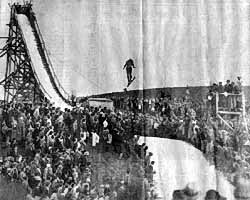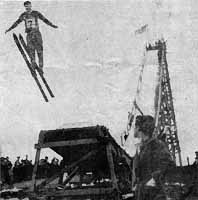|
Ski Berkeley!
by Mark McLaughlin
Click here to watch a short video of the 1935 Berkeley ski jumping exhibition.
For more than a century snow-starved winter sports enthusiasts from California have enjoyed weekends and holidays playing in the Sierra s now. Today's urban snow lovers travel up to the Sierra via all-weather highways in the comfort of sturdy all-wheel-drive SUVs, but in the 1930s and 1940s,
proponents of winter sports actually delivered the goods directly to the city. In February 1934 the recently organized Auburn Ski Club first introduced ski jumping to the San Francisco/Bay Area
by co-hosting an event on the University of California — Berkeley campus. The previous year California's governor, James Rolph, Jr., had proclaimed the first week of January 1934 as "Winter
Sports Week for California." Although California enjoyed an enviable reputation for sunny beaches and palm trees, Gov. Rolph stated, "In recent
years the people of California have come to realize the value of this winter recreation to the point that winters sports are being developed in this state to
a higher degree than in any other part of the world. In the promotion of this new industry for California, it is my sincere wish that all the people of the state
participate in this healthful recreation during this week and throughout the winter." now. Today's urban snow lovers travel up to the Sierra via all-weather highways in the comfort of sturdy all-wheel-drive SUVs, but in the 1930s and 1940s,
proponents of winter sports actually delivered the goods directly to the city. In February 1934 the recently organized Auburn Ski Club first introduced ski jumping to the San Francisco/Bay Area
by co-hosting an event on the University of California — Berkeley campus. The previous year California's governor, James Rolph, Jr., had proclaimed the first week of January 1934 as "Winter
Sports Week for California." Although California enjoyed an enviable reputation for sunny beaches and palm trees, Gov. Rolph stated, "In recent
years the people of California have come to realize the value of this winter recreation to the point that winters sports are being developed in this state to
a higher degree than in any other part of the world. In the promotion of this new industry for California, it is my sincere wish that all the people of the state
participate in this healthful recreation during this week and throughout the winter."
To prepare for the Berkeley tournament 43,000 cubic feet of snow were shipped in from the Si
|
5,000 college boys and youngsters charged through police barriers, and the event
soon turned into a massive snowball fight.
|
|
erra loaded on six Southern Pacific boxcars. Held at the head of Hearst Avenue, just north of the University of California campus, the
extraordinary event attracted more than 50,000 spectators. Ski jumpers Orlan Sanders, Jesse Maxsom, Jr., and Earl Edmunds represented the Truckee Ski Club, while Squaw Valley founder Wayne Paulsen, competed for the
Auburn Ski Club. The novelty of ski jumping in the Berkeley hills captured everyone's imagination, but the tournament ended in disarray when a
riot broke out as the first of a series of exhibition jumpers poised at the top of the 450-foot slide. About 5,000 college boys and youngsters charged through
police barriers and the event soon turned into a massive snowball fight with the paying spectators in full retreat. Another 45,000 people without tickets
crowded onto Tightwad Hill above the edge of the campus to watch the festivities. (Tightwad Hill earned its moniker because spectators often climbed it to watch Cal football games for free.) Tournament officials
estimated the number of paid admissions at only 5,000. California Ski Association officials charged Berkeley police with incompetence and insufficient protection "which cost the association from $6,000 to $10,000 in
paid admissions." (Preferred seating cost $1.00/ general admission was 55¢.) The unruly, tight-fisted crowd ruined any chance of the ski clubs raising
money that had been earmarked to further the interests of winter sports in California.
Reluctant to abandon their efforts to promote the benefits of winter sports, officials with the Auburn and California ski clubs hosted a  second Berkeley ski jumping tournament on January 13, 1935. Once again they received additional support from the California Chamber of Commerce,
the San Francisco Winter Sports Club, and other like-minded organizations that hoped to make the spectacular ski jump an annual event. Volunteers erected a scaffold 85 feet
high on the crest of a grassy hill just north of the Greek Theater and Memorial Stadium. The snow-covered, 170-foot long slide was angled at a steep 45 degrees, which enabled
the jumpers to reach speeds in excess of 60 miles per hour. Using tons of snow imported from Donner Pass, an expanded landing zone of snow layered over straw bedding permitted leaps of more
than 150 feet. The daring athletes sped down the icy ramp and launched themselves with grace and skill into the gray sky. Contestants included
nationally known ski jumpers from Chicago, Portland, Los Angeles, Auburn and Lake Tahoe. Several of the competitors would compete the following year in the Olympic Winter Games in the German Alps. second Berkeley ski jumping tournament on January 13, 1935. Once again they received additional support from the California Chamber of Commerce,
the San Francisco Winter Sports Club, and other like-minded organizations that hoped to make the spectacular ski jump an annual event. Volunteers erected a scaffold 85 feet
high on the crest of a grassy hill just north of the Greek Theater and Memorial Stadium. The snow-covered, 170-foot long slide was angled at a steep 45 degrees, which enabled
the jumpers to reach speeds in excess of 60 miles per hour. Using tons of snow imported from Donner Pass, an expanded landing zone of snow layered over straw bedding permitted leaps of more
than 150 feet. The daring athletes sped down the icy ramp and launched themselves with grace and skill into the gray sky. Contestants included
nationally known ski jumpers from Chicago, Portland, Los Angeles, Auburn and Lake Tahoe. Several of the competitors would compete the following year in the Olympic Winter Games in the German Alps.
The popular skier and former U.S. ski champion, Roy Mikkelsen of Auburn,
took first place with a soaring leap of 139 feet followed by a perfect telemark landing. Mikkelsen emigrated from Norway in 1924 and acquired U.S.
citizenship in 1932, the same year he entered and won the National Ski Jumping Championship held at Lake Tahoe's Olympic Hill. The gifted and
good-natured Mikkelsen laughed after skiing into the encroaching crowds following his landing. "I guess we can't stretch the jumps too long here," he
said, "You might land down in the Berkeley shopping district."
Despite police precautions and excellent advertising, the sponsors were unable to get enough cash customers through the gate to pay expenses. Only
4,000 people paid admission to the event, while an estimated 10,000 more stood outside the gates at the top of Hearst Avenue and gazed upward for
free. And of course, as soon as the contest concluded and the police and National Guard units departed the scene, another free-for-all snowball fight broke out among the snow-starved flatlanders.
|



